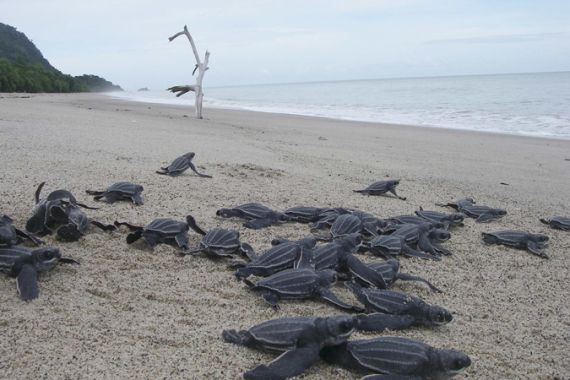Environmental summit ends with historic pact
Wildlife convention closes in Bangkok with long-awaited deal on sharks, but pressing environmental issues remain.

As a landmark wildlife conference, the meeting of the Convention on International Trade in Endangered Species of Wild Fauna and Flora (CITES) could be considered a roaring success.
It started with a pledge from Thailand to end its domestic ivory trade and ended with an historic agreement to restrict the commercial trade in sharks and manta rays. Even so, toothy issues remained for the world’s environmental community.
Keep reading
list of 4 itemsAfter the Hurricane
World’s coral reefs face global bleaching crisis
Why is Germany maintaining economic ties with China?
As CITES delegates wrapped up two weeks of discussions in Bangkok on Thursday, there were still outstanding concerns about shaky regional enforcement, and slack national laws that give criminals opportunities to elude international bans on wildlife trafficking.
Representatives from 178 countries, as well as trade groups and conservationists, deliberated on some 70 proposals during the meeting, which began March 3 and is held every three years.
According to its website, CITES is “an international agreement between governments [to] ensure that international trade in specimens of wild animals and plants does not threaten their survival”.
The decision to regulate the trade of several species of shark and manta ray was seen by many observers as this year’s capstone achievement. Some 100 million sharks are taken from the sea each year for their fins, according to some estimates.
“This is a historic moment, where science has prevailed over politics, as sharks and manta rays are being obliterated from our oceans,” Dr Carlos Drews, head of WWF’s CITES delegation, said in a statement.
“This decision will put a major dent in the uncontrolled trade in shark meat and fins, which is rapidly destroying populations of these precious animals to feed the growing demand for luxury goods.”
Trees and turtles
Other accomplishments included the listing of hundreds of timbers species, including Thai rosewood, for the first time and the passage of proposals to limit the trade in tortoises and turtles.
CITES’ successes in Bangkok are likely to give renewed impetus to the 40-year-old organisation, as it seeks to regulate trade that threatens some of the world’s most iconic species.
Still, the profitable business of illegal wildlife trafficking is increasingly attracting the attention of organised criminal gangs, and the enforcement of complex CITES regulations is carried out mostly at the national level.
“The international community has today decided to make best use of this pragmatic and effective agreement to help it along the path to sustainability in our oceans and forests,” said John E Scanlon, CITES secretary-general.
“CITES parties have heeded the call from Rio+20 and recognised the important role of CITES as an international agreement that stands at the intersection between trade, the environment and development.”
Although a US-led effort to ban the trade in polar bear parts was defeated, Craig Hoover of the US Fish and Wildlife Service and part of the US delegation to CITES, said he was encouraged by the discussion in Bangkok.
Hoover specifically cited he action plans adopted by the two countries seen as being the worst offenders in the illegal trade of rhino horn.
“I’ve been to the last six CITES meetings,” said Hoover. “Without question, this has been the most successful, from our perspective.”
Doubts remain
The next meeting is due to take place in South Africa in 2016, where populations of rhino, listed since 1977 under CITES Appendix I, which bans all commercial trade, are under pressure.
Rising demand from Asia, particularly Vietnam, where rhino horn is touted as a cure for cancer even though there is no evidence to support the claim, is fuelling poaching. A record 668 animals were killed in South Africa in 2012.
CITES asked Vietnam to devise a strategy to reduce demand for rhino horn and develop a secure database of horn trophies.
Mozambique was called on to tighten laws to reduce the trade and take tougher action against poachers operating in the Kruger National Park in neighbouring South Africa, which allows limited trophy hunting of rhino.
Both have to report back by January 2014 and provide definitive information on the number of arrests, seizures and prosecutions. Failure to respond could result in sanctions.
Still, some remain sceptical about the CITES process.
‘Follow through’
The ivory trade has long been touted as the organisation’s biggest success, following a trading ban that was imposed in 1989, but some 25,000 African elephants are thought to have been killed for their tusks last year.
The success of the ivory trade is helped by the occasional sales of stockpiled ivory and the challenge of enforcing an international ban when some countries, such as Thailand, still allow trade within their own borders.
Although Thai Prime Minister Yingluck Shinawatra’s opened the convention with a promise to crack down on Thailand’s ivory trade, some NGOs say CITES appears to have done little more than stimulate demand.
“It’s worrying,” said Grace Ge Gabriel, Asia regional director at International Fund for Animal Welfare, who attended the CITES discussions.
“We feel that CITES is at risk of losing its original mandate. CITES was established as a conservation convention regulating trade. But I see CITES is repeatedly putting its precautionary principle aside. It is at risk of becoming a trade convention that’s regulating conservation.”
Conservationists note that many populations of wild animals and plants continue to decline despite the web of laws and regulations that are supposed to protect them.
“The challenge now is for CITES to build on this momentum and ensure it follows through on what was agreed here in Bangkok,” said Hoover.